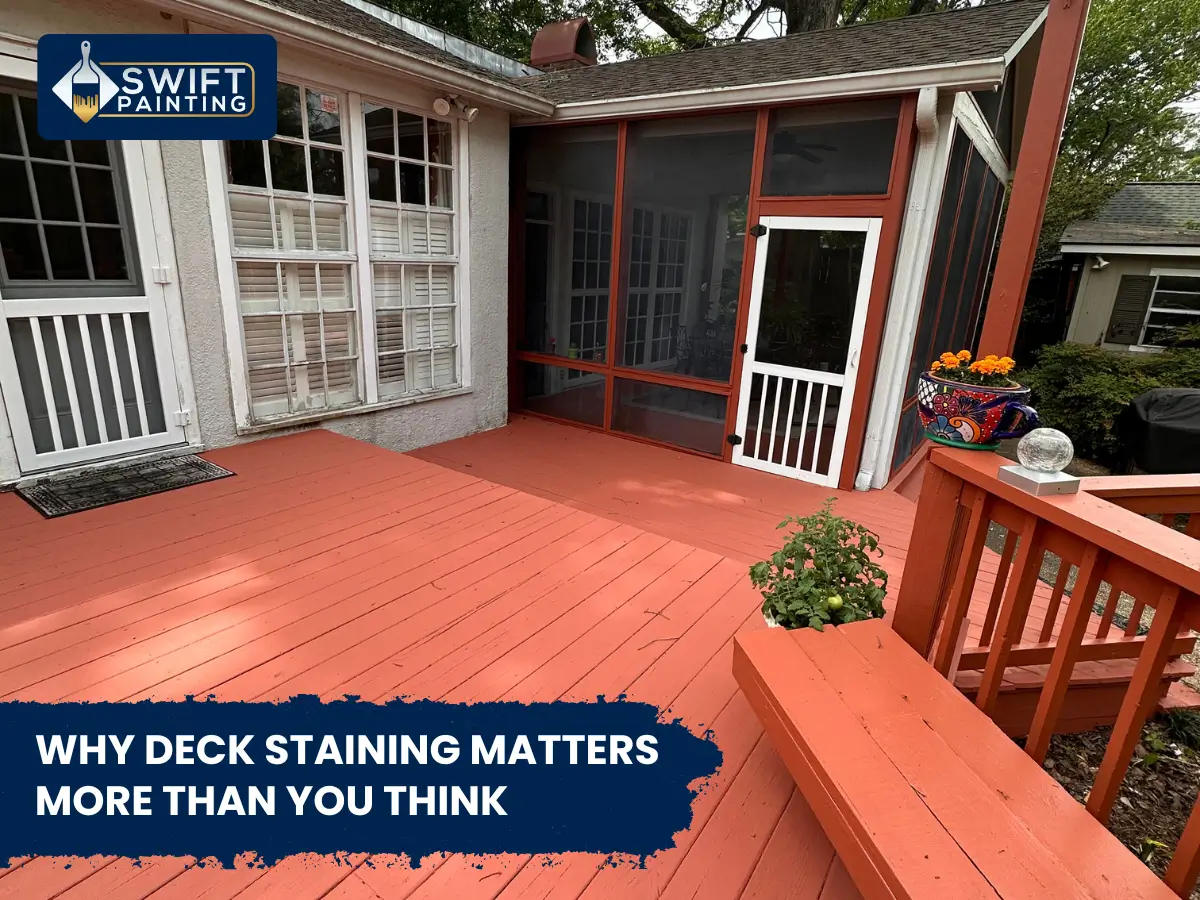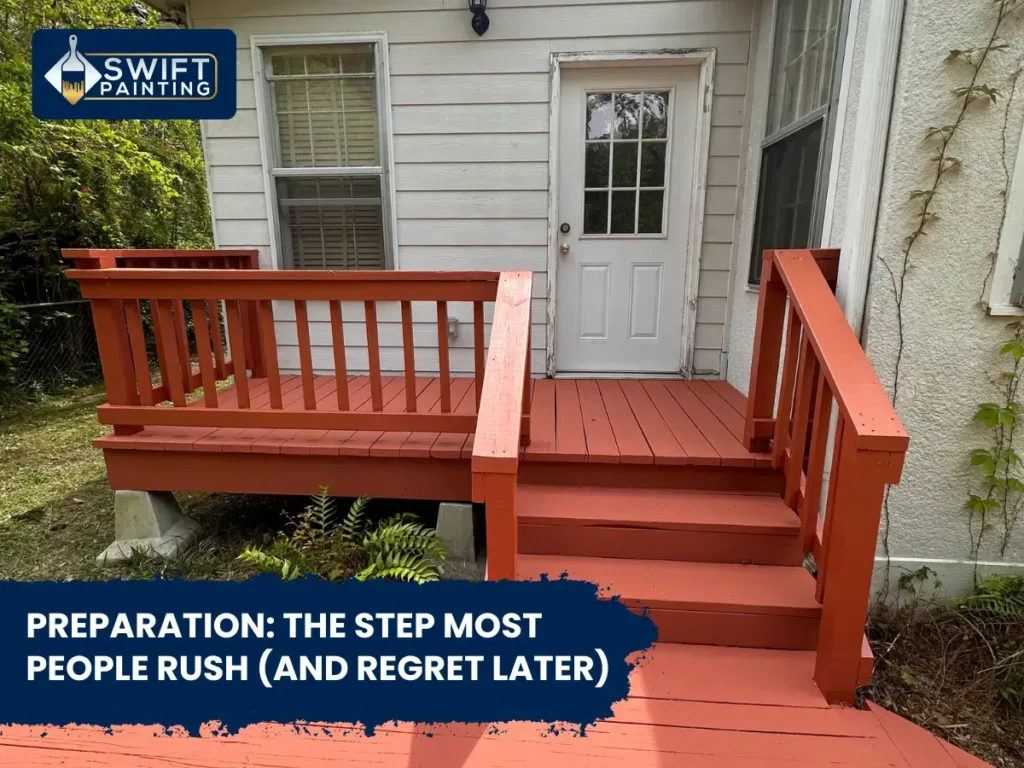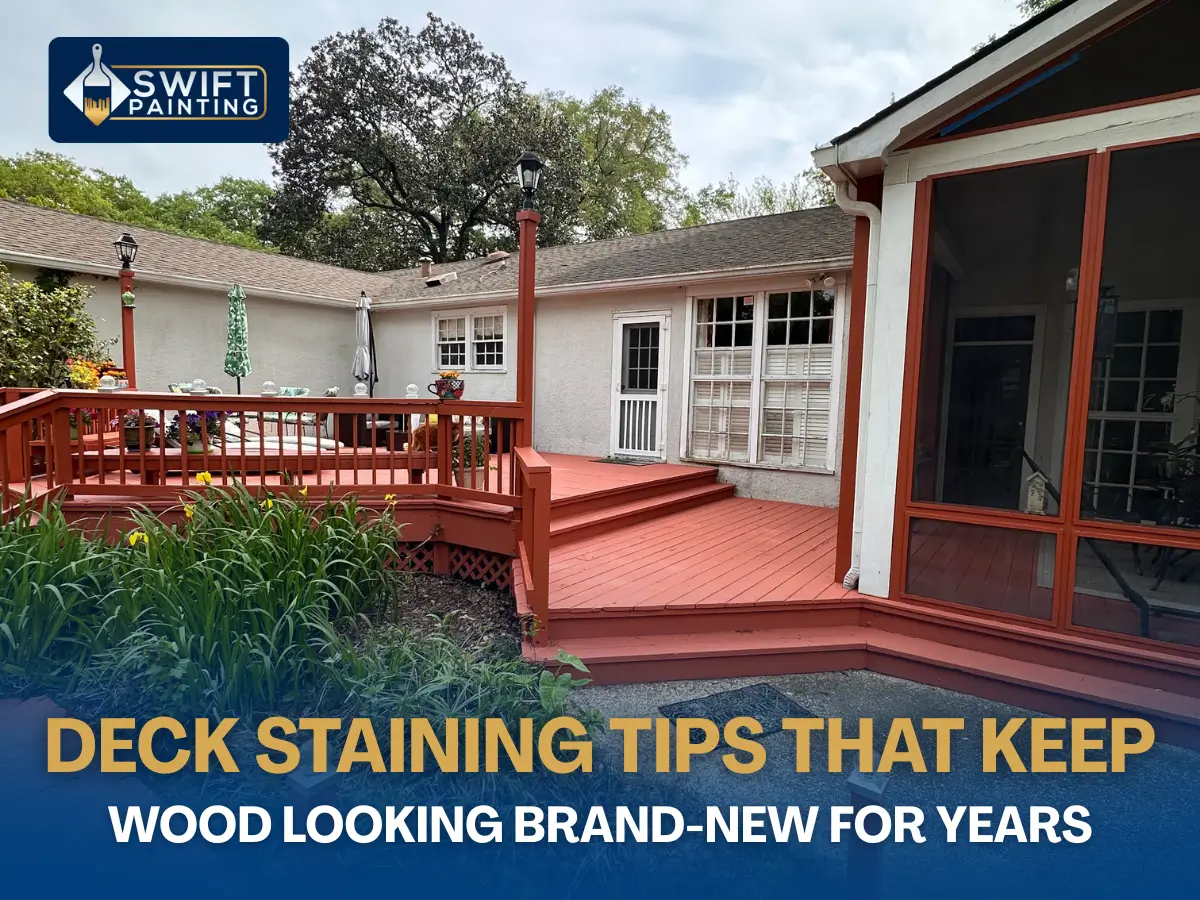A Freshly Stained Deck Is Like Summer in a Snapshot
A deck isn’t just lumber nailed together. It’s the backdrop of summer cookouts, late-night talks, and barefoot walks with coffee in hand. But here’s the truth—if you don’t protect it, the wood won’t stay that golden honey color you loved on day one. Sun, rain, and constant foot traffic turn it gray and tired-looking fast. That’s why deck staining matters. It’s more than just “coloring the boards.” It seals the wood, shields it from harsh UV rays, keeps moisture out, and makes sure those Saturday barbecues feel just as good ten years from now as they do today.
Why Deck Staining Matters More Than You Think

Staining isn’t just about color—it’s protection. A deck takes a beating from the sun’s UV rays, moisture, mold, and endless footsteps. Without stain, wood soaks up water, swells, and then cracks when it dries. Add in the blazing sun, and you’re left with faded, lifeless planks.
A good stain works like sunscreen and raincoat rolled into one. It locks out moisture, protects against UV damage, and brings out the natural beauty of the wood grain. Think of it as skin care for your deck—skip it, and you’ll see wrinkles and cracks much faster.
Choosing the Right Stain: The Foundation of Success
Not all stains are created equal. Choosing the right type is the first step to a long-lasting finish.
Transparent vs. Semi-Transparent vs. Solid Stains
- Transparent stains let the natural grain show through but offer the least UV protection.
- Semi-transparent stains strike a balance, showing some grain while giving solid protection.
- Solid stains act almost like paint. They cover the grain but give the longest-lasting shield.
Most homeowners prefer semi-transparent stains for that classic wood look with reliable durability. But if your deck is older or already weathered, a solid stain may be the smarter choice.
Preparation: The Step Most People Rush (And Regret Later)

Here’s where many DIY deck staining projects go wrong—prep work. You can’t just slap on stain and expect miracles. Wood needs a clean, smooth surface for the stain to bond.
Steps That Make All the Difference
- Clear the space. Remove furniture, grills, and planters so every inch is accessible.
- Clean the deck. Use a deck cleaner or mild soap to remove dirt, mildew, and old residue. A power washer can help but don’t go too strong—it can damage the wood.
- Sand if needed. Rough spots or splintered areas should be sanded to ensure even absorption.
- Check the weather. Stain needs dry wood and mild temps. Ideal conditions are between 50–80°F with no rain for at least 48 hours.
Skipping prep is like painting over dust—it looks fine for a week, then peels and flakes.
Application Tips: Staining Like a Pro
When it comes to deck staining, technique matters just as much as the product. A few missteps can lead to blotches, streaks, or uneven color.
Pro Tips for Smooth Results
- Work in small sections to avoid lap marks.
- Apply with a brush or pad rather than just a sprayer. Sprayers are fine for coverage, but brushing helps push stain deep into the wood.
- Always follow the grain of the wood, never against it.
- Don’t overload the brush. Thin, even coats prevent sticky patches.
The first coat soaks in like a thirsty sponge. If the wood still looks dry, a second coat seals the deal.
Timing Is Everything: How Often Should You Restain?
Most decks need re-staining every 2–3 years. But here’s a trick: splash a little water on the boards. If it beads up, the stain’s still good. If it soaks in, it’s time to restain.
Direct sunlight, heavy rain, or heavy foot traffic may shorten that timeline. A covered deck may last longer, while one baking in the afternoon sun may need more frequent touch-ups.
Common Mistakes to Avoid

Even experienced DIYers mess this up. Don’t fall for these traps:
- Staining wet wood. Stain won’t stick if the boards are damp. Always let the deck dry completely after washing.
- Too much stain. More isn’t better. Over-applying leads to sticky surfaces that never fully cure.
- Ignoring the edges. The sides of boards soak up water too. Seal them properly.
- Skipping maintenance. A quick rinse every few weeks prevents dirt buildup that breaks down stain faster.
Maintenance Habits That Extend Deck Life
Staining isn’t a one-and-done deal. Regular care keeps the wood healthy and the stain strong.
- Sweep away leaves and dirt weekly. Trapped moisture breeds mold.
- Move furniture around sometimes to prevent uneven fading.
- Rinse with a garden hose once a month.
- Touch up scratches right away to stop water damage from spreading.
Think of it like oil changes for your car—small effort now saves big repairs later.
A Personal Note: The Deck That Taught Me Patience
Years ago, I helped my uncle stain his deck. He rushed it—didn’t sand, didn’t check the weather, just brushed on one coat. Within six months, the boards were peeling, blotchy, and faded. He had to redo the entire job the next spring.
Meanwhile, my neighbor took the slow approach—power washed, sanded, waited for perfect weather, and applied two thin coats. Ten years later, her deck still looks photo-worthy. That was the moment I realized deck staining isn’t just a task—it’s a ritual that rewards patience.
Closing Thoughts
Deck staining isn’t a glamorous job, but it’s the secret to keeping your outdoor space looking like new for years. The right stain, applied with patience and proper prep, doesn’t just protect the wood—it protects the memories made on top of it. Think of it as preserving the stage for summer evenings, family barbecues, and quiet Sunday mornings. Put in the care now, and your deck will reward you with beauty, safety, and durability long after the brush is cleaned.
Ready to bring your deck back to life? Contact Swift Painting LLC today for professional deck staining and restoration that keeps your outdoor space looking its best, season after season.
FAQs About Deck Staining
1. How much does deck staining usually cost if I hire someone?
Prices depend on the size of your deck and the stain used, but most homeowners spend between a few hundred and a couple thousand dollars. While DIY saves money, professionals bring consistency, speed, and the right equipment to handle tricky areas.
2. Will staining my deck make it slippery?
Not if it’s done correctly. A quality stain penetrates the wood rather than sitting on top, which keeps the surface grippy. If you over-apply and leave shiny patches, that’s when it can feel slick after rain.
3. Do I need to move all my outdoor furniture before staining?
Yes, everything needs to come off. Even small items like planters or rugs can leave marks or block stain from reaching certain spots. It’s extra work, but it ensures an even finish across the entire surface.
4. How bad does the smell get, and is it safe for kids or pets?
Most modern stains are low-VOC, which means the smell isn’t overwhelming, and once dry, they’re safe. Still, it’s a good idea to keep kids and pets off the deck until it’s fully cured—usually 24 to 48 hours.
5. What happens if I don’t stain my deck at all?
The wood will start to soak up water, leading to swelling, cracking, and eventually rot. Sunlight will bleach it gray, and the boards may splinter. Skipping stain might save effort in the short term, but in the long run, you’ll be replacing boards—or the whole deck—far sooner than you’d like.




